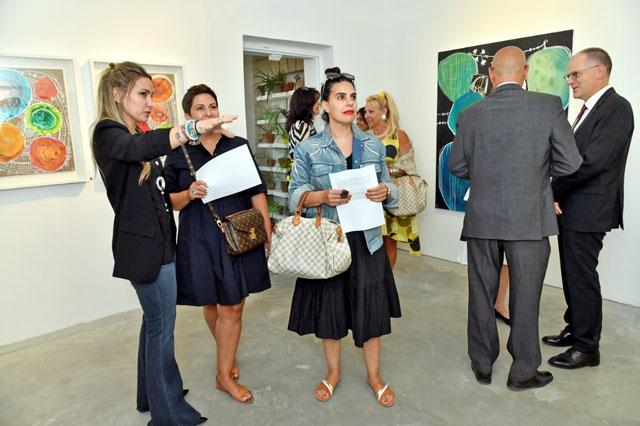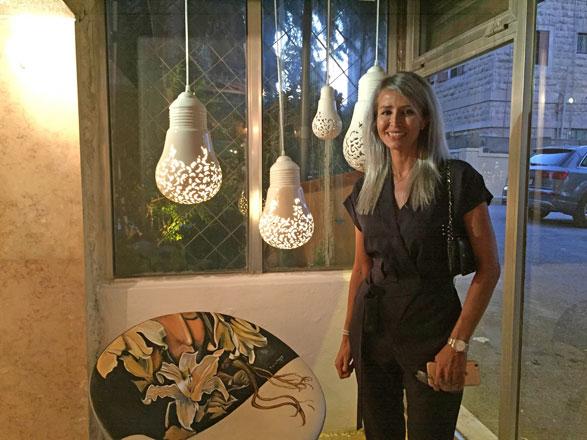You are here
Wadi Finan exhibit tries to challenge concepts of traditional audience, art form
By Yasmeen Kanaan - Mar 03,2019 - Last updated at Mar 03,2019

Artist Yasmeen Sabri (2nd from right) talks to attendees of her ‘Transcendence’ exhibit, in this undated photo (Photo courtesy of Wadi Finan)
AMMAN — In the pursuit of transcending into an art world where common man is no longer excluded, performance and visual artist Yasmeen Sabri offers spectators possibilities to reimagine what constitutes art and to sink into an encapsulating experience of “the raw and the cast out”.
On the walls and in the walking spaces of Wadi Finan, Sabri aspired, through her solo show “Transcendence”, to forge an experience for every person to come in and comprehend the exhibits as they themselves are. The exhibition will be run through March 28.
“The art piece is not completed by myself, but by the viewer, by their history and opinions. I try to instigate this meditative state but it’s up to the viewer to create that feeling for himself.”
Sabri’s work is driven by her belief in the power that art galleries withstand; trusting that wherever there is art “there is conversation and discourse”. With such capacity, the artist takes advantage of the freedom to appropriate and strip materials out of their historical context, making them exist as an absolute form of art.
Despite the diversity of the display, the coming together of the found, the discarded, trash or the unseen, paved the way for the show’s feel of “wholeness”. Her compulsion towards the use of cheap materials designed for construction tunes into the concept of giving the ignored and avoided a different feel — a life.
“I don’t use material that is meant for art. Or, I use material that is used for art, but in a different way. I use objects that I find; broken signs, discarded pallets, things that are usually thrown away. I don’t use the canvas to paint on it; I use it in itself as the artwork. The fabric is not used as a surface for the artwork, it is the artwork,” Sabri said.
Sabri further explained her choice for the materials as a means to break the hierarchical image mired in the “white cube”. Every material incorporated is intertwined with her endeavour to break the stigma of who is allowed into a gallery.
“I think of people who use these materials — construction workers who are eventually not welcomed into the spaces they build. They build a gallery, but then they are excluded from it. By using these materials, I’m putting them on display again and I am inviting them.”
In a reply to a question by The Jordan Times on why she chose to be confined within an art gallery while a show on the street could be more parallel to such a concept, Sabri said: “I am breaking stigma by deciding on who gets to visit my show. I’ve made sure to invite all the craftsmen, electricians and carpenters who helped me produce the works, along with their families.”
According to Sabri, this is the state of “transcendence” she is communicating; where the material itself is transcending in itself.
“The materials are transcending from what they are supposed to be; these objects are not supposed to be in a gallery, and definitely not on the walls.”
Her choice for the title, “Transcendence”, also refers to the state that Sabri herself experiences while her artwork directs itself into its creation.
“When I’m creating the work, I don’t think or plan, the process is very impulsive. The material starts navigating the work. Some colours reject each other or mix in a certain way; it’s like a performance frozen in time for the viewer. And I am as relevant to the piece as the brush, the colours and the fabrics. These elements interact with each other in a way to create their own story. I listen to the work and the fabric”.
Although Jordan is not yet in the process of embracing non-traditional forms of art, Sabri shared her optimism on introducing such contemporary approaches to the Jordanian art scene.
“People are always open to it. I want to give them the safe space to explore their mind, their own feelings. And by putting it on walls, I’m also inviting people to question what is art, what is required of someone to be an artist and the work to be labelled as art.”
Related Articles
AMMAN — In a fast-paced world where motherhood has become an underrated role, artist Nissa Raad celebrates the core of what it means to be a
AMMAN — The Zara Gallery on Wednesday inaugurated a group exhibition by Jordanian female artists, under the title “Delicate Lines of Strengt
AMMAN — Inspired by the female identity, Syrian artist Rana Sunaij creates works of art from timeworn furniture to produce functional design



















